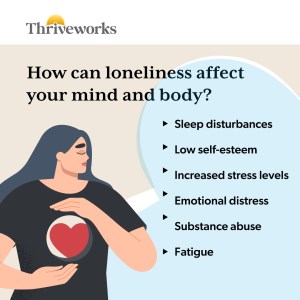When we feel disconnected and isolated from others, loneliness can start to take hold. Loneliness is a natural but emotionally and physically intense response to feeling disconnected from other people. That said, even when we’re surrounded by others, it’s still possible to wrestle with loneliness.
Loneliness has an intrinsic connection to our physical and mental health, so it’s important to be able to recognize it and do what you can to help yourself out of it.
What Defines Being Lonely?
Loneliness is a subjective feeling of social isolation or a lack of companionship, which can occur even when one is surrounded by other people. It is a complex and multifaceted emotion that can be experienced by anyone, regardless of their social status or the number of relationships they have. Loneliness can manifest as a deep sense of emptiness, sadness, or disconnection from others, and can be described as an intense longing for human companionship.
It’s not only a state of mind, either; it can have a severe emotional and physiological impact on the sufferer over time. Loneliness can age the human body prematurely, even causing as much damage to the cardiovascular system as habitually smoking cigarettes. Loneliness affects all major systems in the body negatively, including our circulatory system, our nervous system, and our lymphatic system.
However, being alone does not necessarily equate to loneliness, as some individuals may find contentment and fulfillment in solitude. Conversely, one can feel lonely even in the presence of others if there is a lack of meaningful connection or understanding.
Addressing loneliness often involves cultivating meaningful relationships, engaging in social activities, and seeking support from friends, family, or mental health professionals. It’s essential to recognize and acknowledge loneliness as a valid emotional experience and take steps to address it for the sake of one’s well-being.
Are Loneliness and Being Alone the Same Thing?
Being alone and feeling alone (loneliness) aren’t the same. This is due to the psychological aspect of loneliness. Even when surrounded by other people, it’s possible to feel alone. Being alone, on the other hand, is about physical proximity—being alone means there’s no one else around, but that doesn’t necessarily mean it’s a negative experience.
True loneliness is as much about missing physical contact as it is about having a genuine emotional connection with other people.
However, being alone, whether it’s a purposeful choice or not, can certainly trigger feelings of loneliness. Human contact is both necessary and helpful in staving off the sadness, frustration, and possible depression that can be brought on by extended periods of isolation. This, in a nutshell, is what connects being alone and loneliness—both states of being can play off of each other.
What Are the 3 Types of Loneliness?
Loneliness can be broken into three types based on the reasoning behind the loneliness. The three types are:
- Emotional loneliness: Feeling lonely due to the absence—or perceived absence—of meaningful relationships in one’s life.
- Social loneliness: Feeling lonely due to the belief that one’s social connections lack the quality and depth desired from them.
- Existential loneliness: Loneliness derived from feeling fundamentally or inherently separate from people and the world around oneself.
Loneliness can also be categorized into two types: situational loneliness and chronic loneliness. Situational loneliness is a temporary state that arises from specific circumstances, such as:
- Moving to a new place
- The end of a relationship
- The loss of a loved one
- Life changes like pregnancy or illness
- Experiencing disabilities
- And more
Chronic loneliness, on the other hand, is a persistent and long-term experience of feeling disconnected and isolated, often resulting from a lack of meaningful social connections or a sense of belonging.
Traits of a Lonely Person: What Are Signs of Loneliness?
Loneliness can manifest differently in individuals, and it’s important to note that experiencing loneliness does not necessarily mean someone possesses certain traits. Signs of loneliness can vary from one person to the next, based largely on their personality. This includes their social habits (are they introverted or extroverted?) their tendency to display emotions, as well as their coping methods.
However, there are some common characteristics that may be associated with individuals who often feel lonely. Below are a few traits that lonely people may exhibit:
- Seeming withdrawn or unwilling to engage with other people: Lonely individuals often tend to withdraw from social interactions and isolate themselves from others. Though this might sound contradictory, lonely individuals might find it harder to engage with others after long periods of extended isolation. When loneliness becomes routine, motivation to socialize might wane. They may avoid social gatherings, prefer solitude, or struggle to initiate or maintain meaningful connections.
- Difficulty forming connections: Loneliness can be accompanied by challenges in forming deep and meaningful relationships. Lonely individuals may find it hard to relate to others, have low self-esteem, or struggle with trust, making it difficult to establish and maintain close friendships or romantic partnerships.
- Substance abuse, including alcohol or illicit drugs: Like many other negative mental health states, loneliness can cause people to start self-medicating with drugs or alcohol. These substances might temporarily alleviate some of the intense emotional and physiological pain that loneliness can create, but the danger of long-term addiction is ever-present.
- Low self-esteem: Loneliness can be associated with low self-worth and a negative self-perception. Individuals may feel they are unworthy of love and friendship, leading to a cycle of self-isolation and reinforcing feelings of loneliness.
- Out-of-character behavior on social media: This includes posts or pictures involving sad imagery, despondent captions, or passive-aggressive commentary directed at those in their social circle. These sorts of actions may be indicative of feelings of abandonment.
- Lack of social support: Lonely people may lack a strong support network. They might not have close friends or family members they can confide in or rely on for emotional support, leaving them feeling isolated and disconnected.
- Increased sensitivity to rejection: Lonely people may be more sensitive to rejection or perceived slights from others. They might interpret neutral or ambiguous social cues as signs of rejection, which further reinforces their feelings of loneliness and social disconnection.
- Emotional distress: Chronic loneliness often accompanies emotional distress, including feelings of sadness, anxiety, and depression. These emotions can be overwhelming and contribute to a negative spiral of isolation and worsening mental well-being.
- Verbally expressing loneliness: This should be taken seriously by those who are close to the sufferer. Sometimes, when a lonely person wants to communicate how they’re feeling, they use sarcasm or other forms of veiled responses. This might be because they’re embarrassed about feeling lonely—or it could be because they’re trying to take the edge off of a subject that’s painful to talk about. Whatever their reasons may be, it’s important not to brush off their comments.
It’s important to note that these traits are not definitive indicators of loneliness, as individuals may exhibit them for various reasons unrelated to loneliness. Loneliness can also affect anyone, regardless of their personality traits or circumstances.
Are There Physical Symptoms of Loneliness?
While loneliness is primarily an emotional or psychological experience, it can have an impact on physical well-being. Prolonged feelings of loneliness have been associated with increased risk of depression, anxiety, cardiovascular problems, compromised immune function, and even a higher mortality rate. It can also impact cognitive functioning, sleep patterns, and overall well-being.
Here are a few examples of physical symptoms that may be linked to loneliness:
- Sleep disturbances: Loneliness can disrupt sleep patterns, leading to difficulties falling asleep or staying asleep throughout the night.
- Weakened immune system: Prolonged loneliness and social isolation have been associated with a weakened immune system, making individuals more susceptible to illnesses and infections.
- Increased stress levels: Loneliness can contribute to higher levels of stress, which may lead to physical manifestations such as headaches, muscle tension, and digestive problems.
- High blood pressure: Some research suggests a correlation between loneliness and elevated blood pressure, which can increase the risk of cardiovascular problems.
- Fatigue and low energy: Loneliness can drain one’s energy levels, leading to feelings of fatigue and reduced motivation.
- Altered appetite and weight changes: Some people may experience changes in appetite when they are lonely, either eating less or overeating. These changes in eating patterns can potentially lead to weight loss or weight gain.
- Increased inflammation: Chronic loneliness has been associated with increased levels of inflammation in the body, which can contribute to various health issues.
Causes of Loneliness
Some factors that might cause loneliness include:
- Social isolation: When individuals lack meaningful social connections or have limited opportunities for social interaction, they may experience loneliness. This can happen due to factors such as living alone, moving to a new place, lack of close relationships, or a decline in social activities.
- Moving to a new city, state, or country: While a permanent change of scenery can often boost our mental health if new social connections aren’t formed (which takes approximately 300 hours), an individual might start to slip into feelings of loneliness. The chances of this happening are more likely if they choose to remain stuck in old habits that may not transition smoothly into their new environment.
- The loss of a romantic relationship: Romantic relationships can be chemically addictive, according to science. This means that when they end, the steady supply of oxytocin, dopamine, and more — which was fueled by consistent physical touch and other forms of affirmation—is cut off. Those who experience a breakup are likely to spend a period mourning, possibly even passing through the 5 stages of grief. Loneliness is common when one’s romantic partner is suddenly and permanently out of the picture.
- The loss of a friendship: Good friends are hard to come by—and maybe even harder to let go of, it seems. Friendships may not create the chemical dependency we feel in romantic relationships, but social connections with friends are essential to holistic health. Losing a friend may happen for a variety of reasons, but our self-esteem can take a hit if someone lets go of us, or if their toxic behavior forces us to step away. Removing friends from one’s daily life can easily lead to loneliness; replacing them is not only possible but necessary.
- The death of a family member or loved one: The grieving process can trigger a flood of emotions, including feelings of loneliness. Family members often are drawn closer together by death, but there’s still the absence created by the person who’s passed away.
- Mental health issues: Certain mental health conditions, such as depression, anxiety, or social anxiety disorder, can contribute to loneliness. These conditions may affect an individual’s ability to engage in social activities, form relationships, or feel connected to others.
- Technology and social media: Paradoxically, while technology has made it easier to connect with others remotely, excessive reliance on digital communication and social media can lead to feelings of loneliness. Online interactions may not provide the same depth and quality of connection as face-to-face interactions, and excessive screen time can lead to social isolation.
- Lack of social skills or shyness: Some individuals may struggle with social skills or experience shyness, making it challenging for them to initiate or sustain relationships. This difficulty in connecting with others can contribute to feelings of isolation and loneliness.
- World events: The transitions and adjustments caused by world events can upend lives, causing immense amounts of stress, change, and isolation. One of the most recent examples of this is the COVID-19 pandemic. Though we are no longer in a state of emergency, the isolation and loneliness that many felt likely still linger as we struggle to get back to life as we knew it before. Many of us still experience grief, frustration, and aimlessness due to the pandemic—feelings that are hard to shake, and can make us feel lost and lonely.
It’s important to note that loneliness is a complex issue, and the causes mentioned above are not exhaustive. Each person’s experience of loneliness is unique, and addressing it may require a combination of individual strategies, social support, and sometimes professional mental health help.
What Is the Main Cause of Loneliness?
The main cause of loneliness can vary from person to person and is influenced by a combination of factors. Often, though, people become lonely because of some type of life transition or lifestyle choice that reduces the number of perceived connections with other people, both physically and emotionally.
What Are the Effects of Loneliness?
Loneliness, if not dealt with, can cause serious physiological and psychological harm. Loneliness may cause sufferers to experience the following at higher rates than non-lonely individuals:
- Greater risk of cardiovascular illness, including heart disease
- Cognitive decline and signs of neurological aging
- Obesity
- High blood pressure
- Depression
- Anxiety disorders
- Premature death
Loneliness is detrimental to our long-term health. Still, there is a difference between spending time alone and being lonely. Some individuals are introverted; they prefer to spend more time alone than extroverts, and this is perfectly normal. What matters most is the way that time spent alone makes someone feel.

What Do You Do When Loneliness Becomes Unbearable?
When loneliness becomes unbearable, it’s time to talk with a mental health professional. Doing so will help to alleviate some of the mounting pressure and anxiety that often accompany intense feelings of loneliness. The type of provider you’re paired with depends on the severity and symptoms of your loneliness. Short-term, immediate solutions to reducing loneliness, if it becomes unbearable, might include:
- Listening to music or a podcast; while it’s not the same as human contact, hearing someone’s voice, or staying preoccupied with a melody, can help alleviate loneliness
- Adopting a pet, which can often help lower our stress levels and is proven to alleviate feelings of loneliness
- Running, an activity that’s been proven to be a steadfast way to overcome the daily challenges caused by stress, anxiety, and depressive symptoms—all of which can be experienced by lonely individuals
- Taking a drive. Studies have also shown day trips can help alleviate chronic stress and anxiety, which when our environment is altered, may be easier to process
Hello, we're here to help you
We provide award-winning mental health services nationwide, with flexible scheduling & insurance coverage. Start your journey this week.
How to Cure Loneliness
Loneliness is a complex and deeply subjective emotion, and finding a “cure” for it can be challenging. While there may not be a single solution that universally cures loneliness for everyone, there are several approaches and strategies that can help alleviate feelings of loneliness. Here are some suggestions:
- Social connections: Building and nurturing meaningful relationships is crucial for combating loneliness. Engage in activities or join groups that align with your interests and values, such as hobby clubs, volunteering opportunities, or support groups. This can provide opportunities to meet like-minded individuals and form connections.
- Support networks: Reach out to friends, family, or acquaintances and share your feelings. Often, people are willing to provide support and companionship if they are aware of your situation. Consider joining online communities or forums where you can connect with others who may be experiencing similar feelings.
- Self-care and self-compassion: Take care of yourself by engaging in activities that bring you joy and fulfillment. This can include hobbies, exercise, meditation, or pursuing personal goals. Practice self-compassion and focus on cultivating a positive relationship with yourself.
- Technology and online communities: In today’s digital age, technology can facilitate connections and provide avenues to combat loneliness. Participate in online communities, social media groups, or virtual events related to your interests. However, it is important to strike a balance and ensure that online interactions do not replace offline connections entirely.
- Seek professional help: If feelings of loneliness persist or become overwhelming, consider seeking support from a mental health professional. They can provide guidance, therapeutic interventions, and help you explore the underlying causes of your loneliness.
How Can You Overcome Loneliness Without Friends?
Loneliness can be challenging to overcome, especially without a support system of friends to have your back. However, it’s certainly possible to improve your well-being and find fulfillment without relying solely on friends (as you’ll see in some of our tips above). Below are some additional suggestions:
- Engage in activities you enjoy: Pursue hobbies or activities that bring you joy and fulfillment. It could be anything from reading, writing, painting, playing an instrument, gardening, or even volunteering. Engaging in activities you love can provide a sense of purpose and satisfaction.
- Join communities or clubs: Look for local clubs, organizations, or online communities that share your interests. It could be a book club, a sports team, a cooking class, or a discussion group centered around a particular topic. Participating in these communities can help you connect with like-minded individuals and build new relationships.
- Explore online communities and forums: The internet offers a vast array of online communities and forums where you can connect with people who share your interests or experiences. Engage in meaningful conversations, seek advice, and provide support to others. While virtual connections may not replace in-person relationships entirely, they can provide a sense of belonging and camaraderie.
- Focus on personal development: Loneliness can be an opportunity for personal growth. Invest in self-improvement by learning new skills, taking online courses, or reading books on topics that interest you. By focusing on your personal development, you can boost your self-confidence, expand your knowledge, and become more interesting to others.
- Explore new social opportunities: Be open to new experiences and opportunities to meet people. Attend local events, workshops, or seminars related to your interests. Strike up conversations with people you encounter in these settings and be open to forming new connections.
- Seek support from online platforms or helplines: If you’re feeling overwhelmed by loneliness, there are online platforms and helplines available where you can seek emotional support or talk to trained professionals. They can provide guidance and strategies to cope with loneliness and offer a listening ear when needed.
- Develop a fulfilling relationship with yourself: Take the time to develop a positive and nurturing relationship with yourself. Practice self-care, engage in activities that bring you joy, and cultivate self-compassion. By building a strong foundation of self-love and self-acceptance, you can navigate periods of loneliness more effectively.
Remember, overcoming loneliness takes time and effort. It’s essential to be patient with yourself and stay open to new possibilities. If you are trying new tactics and still feel stuck, it can help to speak with a mental health professional about what you’re feeling.













